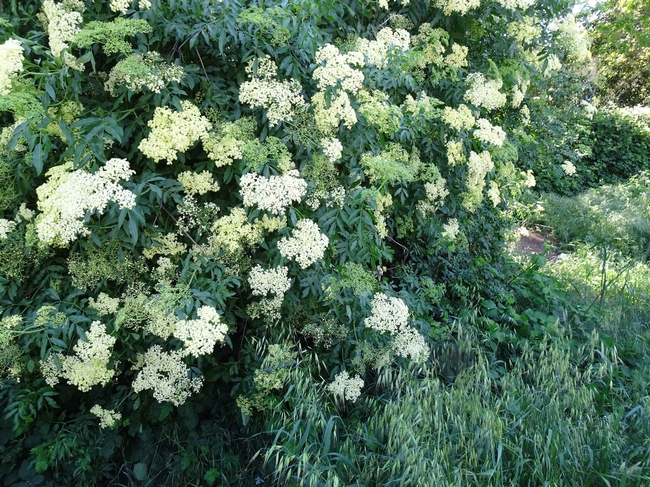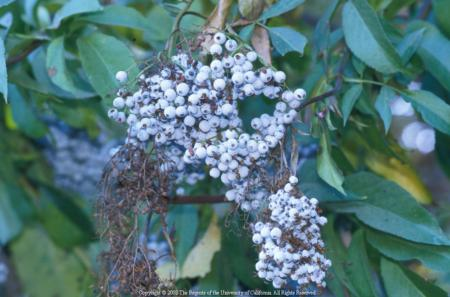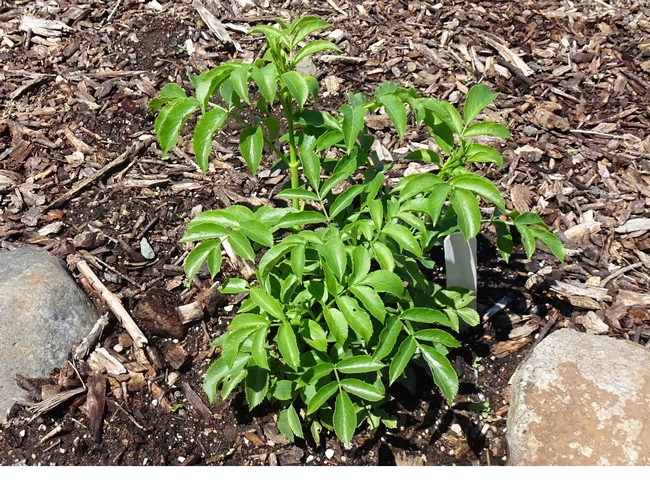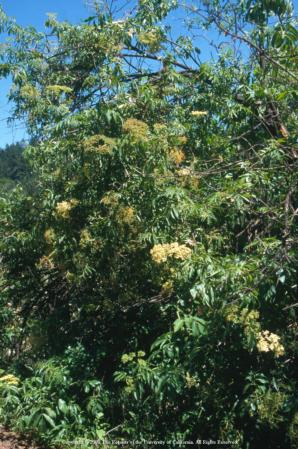Gardeners looking for a drought-tolerant and highly disease-resistant native shrub might consider adding the blue elderberry (Sambucus cerulean also known as Sambucus Mexicana) to their landscape. 
This elderberry's habitat ranges from desert to temperate rainforest, thriving in both full shade and full sun. In good growing conditions in the wild it can reach up to 30 feet high. Its growing habit creates a wide bramble that puts on a spectacular show of flowers and berries in season, but becomes a bit ratty as the summer heat wears on.
The elderberry can be identified through its flowers in late spring, and bunches of blueish berries in mid to late-summer. Typically, hundreds of tiny flowers comprise what appears to be one light cream-colored flower in skyward-facing bunches. A waxy coating on the purple berries gives them their blueish finish. Another distinctive characteristic is that the elderberry is among the first shrubs to show green shoots, sometimes in late fall after the first rains and even well before the California buckeye, another early blooming native.

According to UC Cooperative Extension advisor Rachael Long, the elderberry is one of several natives that provide nectar and pollen for native bees, honey bees, and other insects. “I see a lot of green lace wings (predators of aphids, spider mites and other pests) in elderberry” she notes. The berries are edible for humans if properly prepared. They contain a mild toxin which can easily be cooked out.
The berries and other parts of the elderberry have been valued for their medicinal properties for thousands of years. Modern medical research has established a scientific basis for some medicinal uses that warrant further research. Early Europeans made food and medicine from the berries, and musical instruments from the hollow elderberry branches. In the western hemisphere, Native peoples were using many parts of the plant, well before each culture was aware of the others' existence.

Elderberry references make cultural appearances spanning space and time. In Greek mythology, the Titan Prometheus presented the gift of fire to man in a hollow elderberry branch. In our own time, it is the elder wand, fashioned in part from elderberry wood, which delivers a decisive blow for good over evil in the final chapter of J.K. Rowling's Harry Potter series.
Blue elderberry grows extensively throughout Butte County, favoring streamside locations. For example, in Chico it can easily be found along Big and Little Chico Creeks and Lindo channel. In places along these waterways, there are nearly unbroken stretches of elderberry thickets. The elderberry's tenacity can be seen in the burn-scar area of Butte Creek canyon, where vigorous elderberry canes are re-emerging in profusion.

If you have space in your yard for a hardy native shrub that will provide food for beneficial insects and pollinators, consider the elderberry. It's best to enjoy this multi-use shrub in a section of your yard where it will not be disturbed, and where it can grow to its full size (30 feet) without needing to be trimmed or moved.
The UC Master Gardeners of Butte County are part of the University of California Cooperative Extension (UCCE) system. To learn more about us and our upcoming events, and for help with gardening in our area, visit our website. If you have a gardening question or problem, call the Hotline at (530) 538-7201 or email mgbutte@ucanr.edu.